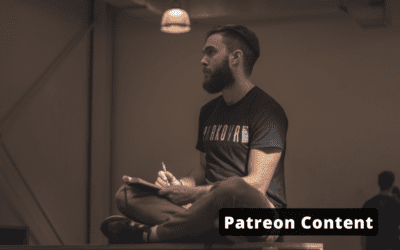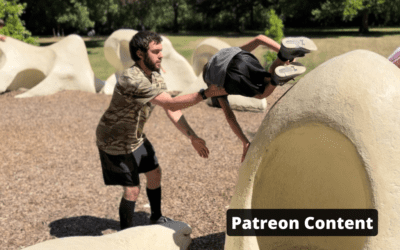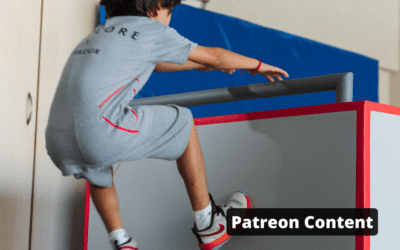Starter Guide
Greetings Explorer!
Before you start your journey we’d like to help you understand the path we’ve charted out here. This page will be explaining how and why we’ve divided up the content in this site. When you see the connections we’ve made we hope that it will inspire you to build your own within your training. We will walk you through our…
- Physical Content
- Exercise Page Layout
- Technical Content
- Technique Page Layout
- Conceptual Content
- Games Page Layout
Feel free to jump around as you wish if you already know what you want by clicking on the relevant link above.
Inside Explore Parkour you’ll see related exerices, techniques and concepts and how related they are to one another. With this knowledge we aim to help you navigate through your own Parkour journey.
As you begin to explore with us remember to be honest with yourself, your intention and how each movement/drill/game is done. Parkour is about learning your own limitations and how you can safely build beyond them. Performing any of these movements incorrectly can lead to short/long term injuries and compromise your health. The content in this site is for informational purposes only. If you are ever unsure seek professional guidance for your training or teaching for the best results.
Physical
The Physical Content developed by Explore Parkour is correlated with 4 Physical Capabilities
Power
Coordination
Endurance
Mobility
Each section will eventually contain relevant articles, drills and exercises to help you in their specific archetypes.
We organize the exercises by their area of predominant effort such as…
| Arms | Torso | Legs |
And even further into their own subdivisions according to how the effort is applied…
| Pushing | Pulling |
And lastly into the direction of effort…
| Forward | Backward |
| Down | Up |
We’ve placed each exercise into one of a handful of Exercise Pages that showcase the foundational movements so you can see all the related progressions and variations to your chosen exercise.
Exercise Page
Below is an example of an Exercise Page (our Pull Up Page) and how each section of it works.
| 1 – Exercise Gif: To show the “Base” Level of the movement. |
| 2 – Main Muscle Groups: Which parts of your body should be the main contributors to this movement. |
| 3 – What’s the Purpose: What specific Parkour Techniques can this apply to. |
| 4 – Technical Tips: Some basic things to focus or think about to help complete this movement effectively. |
| 5 – Progressions: Exercises and drills to help you build up or increase your ability to complete the base exercise. |
| 6 – Modifiers: Ways to change the exercise to give it a different focus or make it more difficult. |
Underneath all of the above content inside the page there are also Related Techniques links so you can see which specific movements the exercise connects to.
Here are some extra notes on the Exercise Page.
The Progressions are there to help you achieve the base technique, we separate them by whether you are struggling with the mobility or strength required for the movement. Look to these if you have any difficulty with the base technique.
The Modifiers are variations of the main exercise, which have the ability to make the base movement more challenging, focus on a different set of muscles, or change the movement entirely. Modifiers are something we apply to our parkour techniques too so that we can explore new challenges. If you’d like to learn more about modifiers check this out.
The Related Techniques are there so you can see what movements you’ve been doing the exercises for! Look here to further explore what you can do when you start building your strength from the exercises. Now that you know how our exercise page works lets check out the technique page layout.
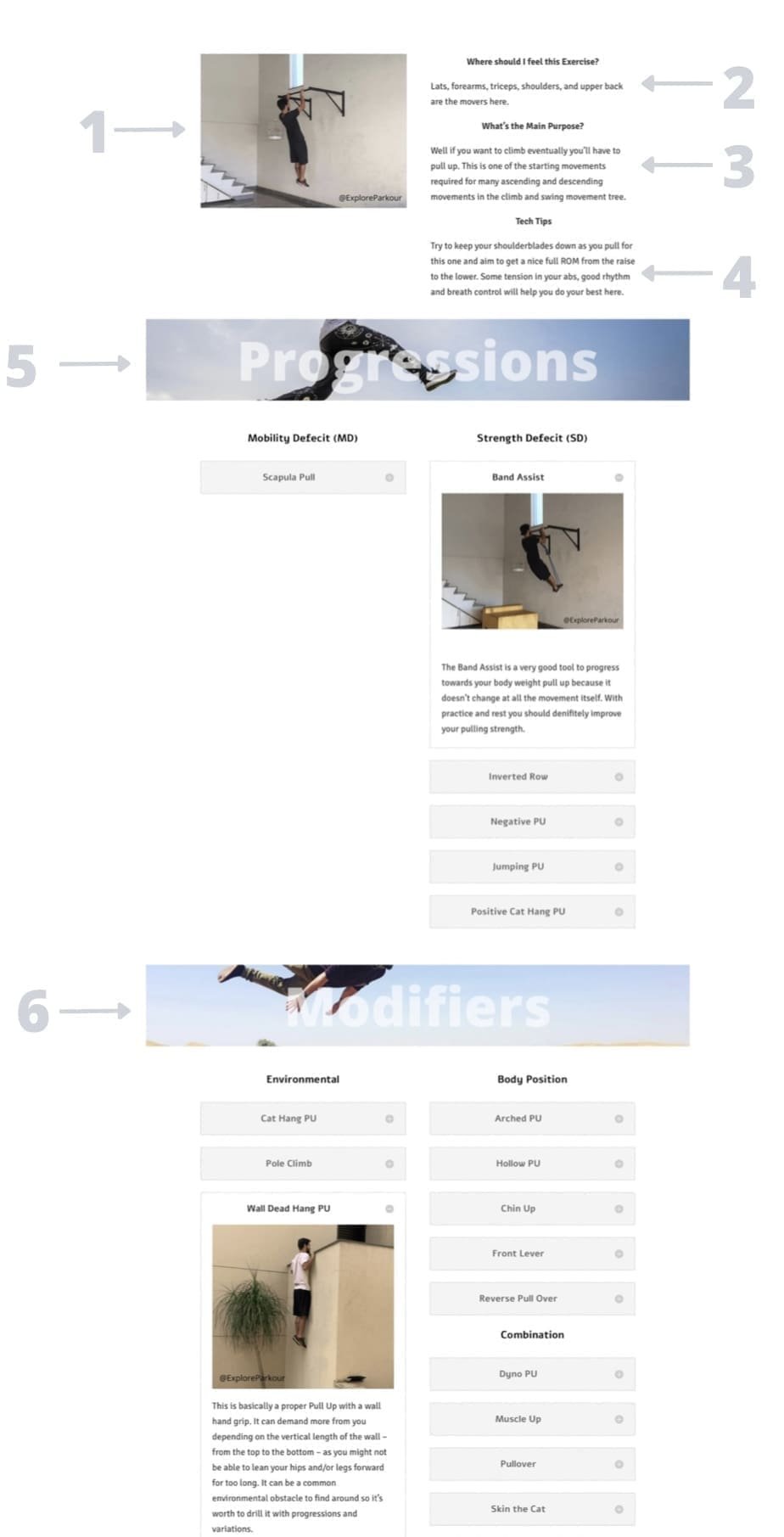
Now that you understand the physical side of XP and it’s exercise page let’s talk Technical.
Technical
The Technical Content developed by Explore Parkour are organized according 9 archetypal groups of movement in the practice of Parkour.
Flip
Roll
Vault
Crawl
Swing
Climb
Jump
Step
Balance
Technique Page
Below is an example of a Technique Page (our Climb Up Page) and how each section inside works.
Other than the above delineations each technique will have it’s own subgroups to further specify which family a technique may be in according to the specific techniques shared traits.
Lets look at our Technique Page now to show how we aim to help you with your techniques.
| 1 – Movement Pieces: Shows the “Base” Level of the movement from different angles. |
| 2 – Common Problems: Shows some of the most common sticking points for the pictured technique. Spread out between the Start, Middle and End of the technique. Use in conjunction with the Movement Pieces section to troubleshoot your own/your students technique. |
| 3 – Progressions: Separated like the Common Problems so that you can break each technique into it’s different parts. This lets you develop each piece of a technique which can then be combined once your ability has improved. Even after you can complete the base movement you can use the progressions to improve on your weakest piece of a technique which will also affect the entire technique. |
| 4 – Modifiers: Potential variations of the technique. By changing one aspect of the technique you can find new challenges or completely different techniques. Listed how the technique is modified. Use these and create your own modifiers to develop your mastery of the technique. This is one huge aspect of exploring parkour so if you’d like to learn more about modifiers check this out. |
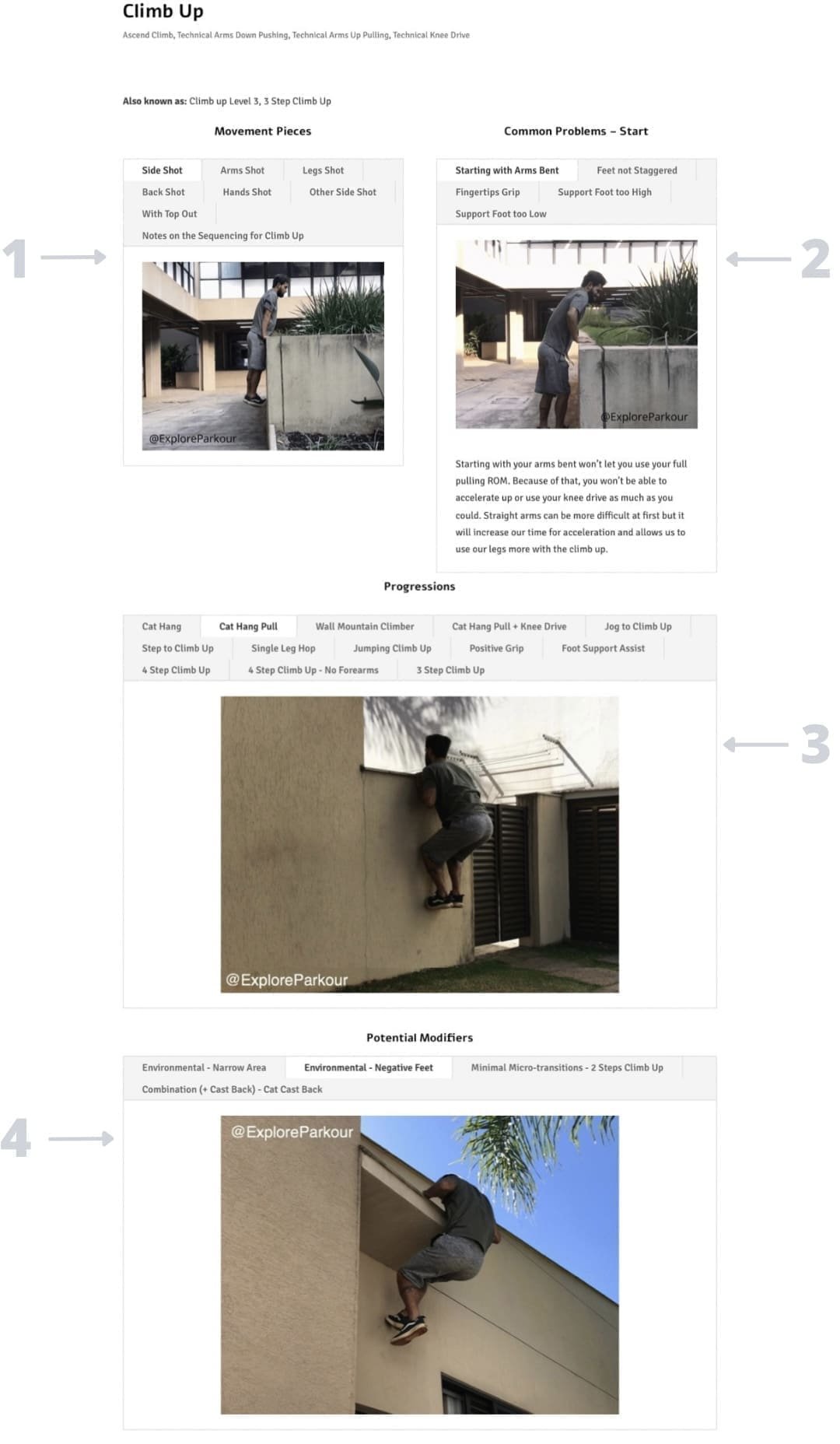
Underneath all of that we have the Related Exercises. This section helps you see physical ways you can improve your technique. If the progressions aren’t attainable yet it can be valuable to look here for how you can improve in the related exercises.
Hopefully this gives you a good idea on how we’ll be approaching the technical content, now lets talk about something a little more abstract, the Conceptual Content.
Conceptual
The Conceptual Content in Explore Parkour is organized through 6 main topics that are focused on the internal and ancillary aspects of Parkour.
| Focus | Strength |
| Momentum | Creativity |
| Utility | Awareness |
We talk about all the above topics through the use of multimedia articles check below for an example gif of what a concept article will look like.
Our Conceptual Articles are aimed to be a bit of a hybrid style with various video, audio, text and image pop ups that can further clarify the points shared in the writings.

It can be a a lot to process when you think about how to apply the technical, conceptual and physical aspects into your or your student’s training. That is where we want to explore the universal concept of play. Below you’ll learn a bit about the Games side of Explore Parkour and how we’ve catalogued, created and adapted various movement games to help us and our students progress on their movement journey.
Games Page
The Games Pages are our efforts to teach and improve in the above topics through play and objective based learning. With the games curated at Explore Parkour you can work on all the aforementioned Conceptual, Technical and Physical content in a different way. In time we hope that you will make and share your own games and variations to help contribute to Parkour and Parkour teaching culture.
Without further ado here is the basic layout of our Games Page.
| 1 – Game Trailer: The game trailer is there to help you understand the feeling of the game and get you excited to play. |
| 2 – Essentials: The essentials are the basics of what you need to make this game happen. We’ve separated the essentials up into the Goal of the game; The Challenge or what makes the game; The Space which is the basic type of area; How many Players are needed for the game; The Props requirements that the game may have and finally we have the Modifiers we’ve used before to alter the game, feel free to play with your own as well! |
| 3 – Rules: The rules or restrictions of the game to help keep it in that nice medium level of challenge. These can be altered as well depending on your specific goals, age groups etc. to add or substract from the difficulty of the game. |
| 4 – Benefits: These are other gains you can glean from this game in its basic form other than just the enjoyment playing the game could provide. As with the rest of our offerings we separate the benefits between Physical, Technical and Conceptual. |
| 5 – Related Content: This will show relevant articles and other games that you can also look into if you’re interested in other ways to play with the concepts or movements inside the game. |
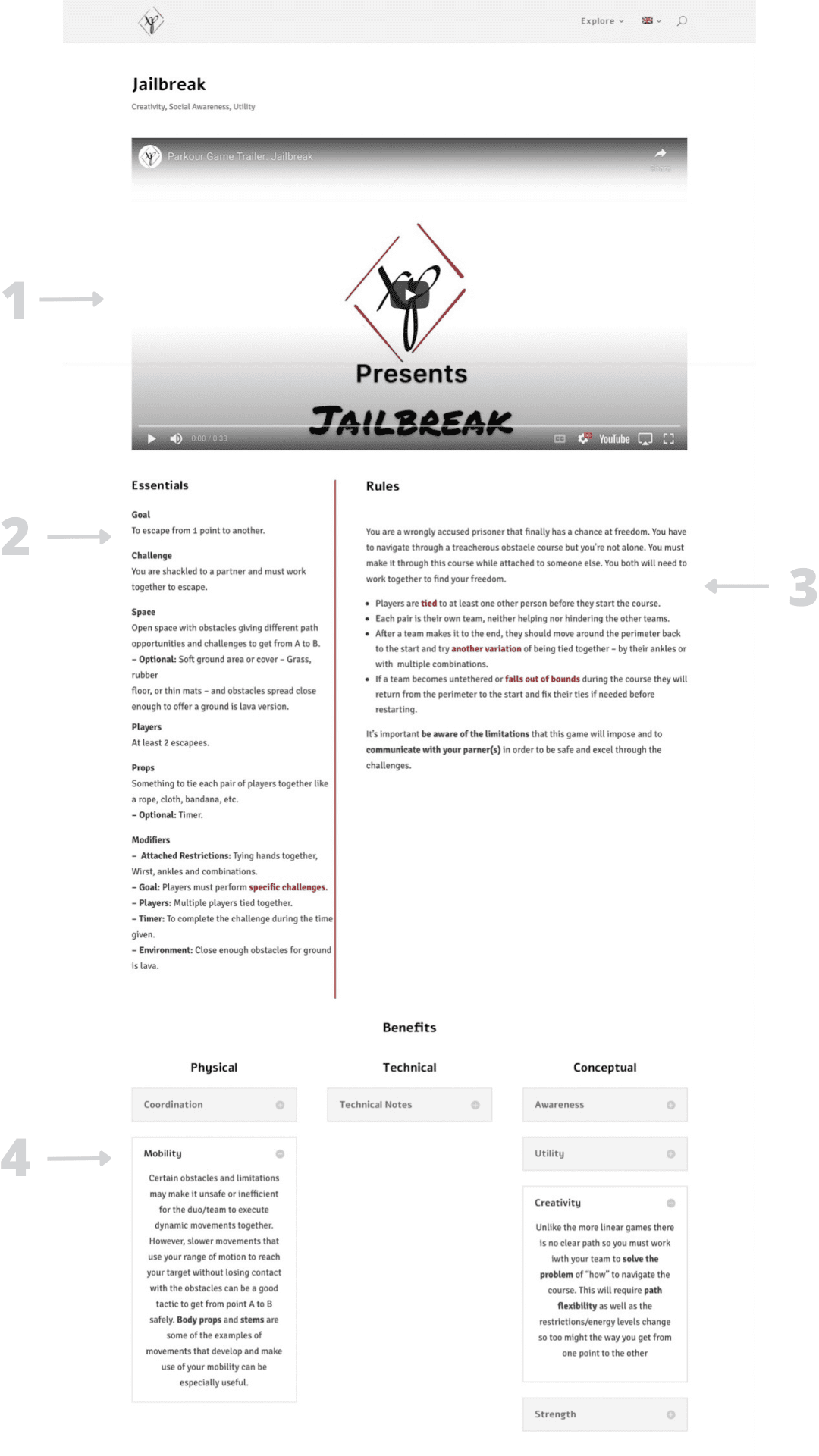
As we grow we will also be looking to offer some different types of Parkour related content such as product Reviews, a Movement Map, and even more. You can check our Free Content Page to see the current content of Explore Parkour.
Now that we’ve primed you we hope you’re ready to take your next steps and we look forward to being a part of your movement journey.
If you’d like to support us on our journey we’ve started a patreon where you can see behind the scenes content, vote on future content releases, be a part of our community and even get one on one guidance from XP contributors depending on your patreon tier. Check out the button below to see all the Patreon info and we will see you on the path. 🙏🏼
Recent Posts
Actionable Feedback
Coaching Content As a teacher we want to make sure we find the right answers for the problems that arise in our students. The answer may not always be the ones we are used to, or the solutions that worked for us. Like an engineer working towards increasing the...
Intro to Spotting
If you’ve ever stood in front of a corner to help protect a friend during a jump or wanted to learn any acrobatic movements then you’ve had some experience with spotting already. Spotting is offering physical and/or emotional support during a movement to make that...
Cat Leap
Also known as: Cat, Arm Jump, Cat JumpMovement Pieces The basic sequence of micro-transitions in this move is… - Like a Precision Jump, start with your toes at the edge of the obstacle. Squat - close to 1/3 - and bring your arms down and back as you lean forward -...

